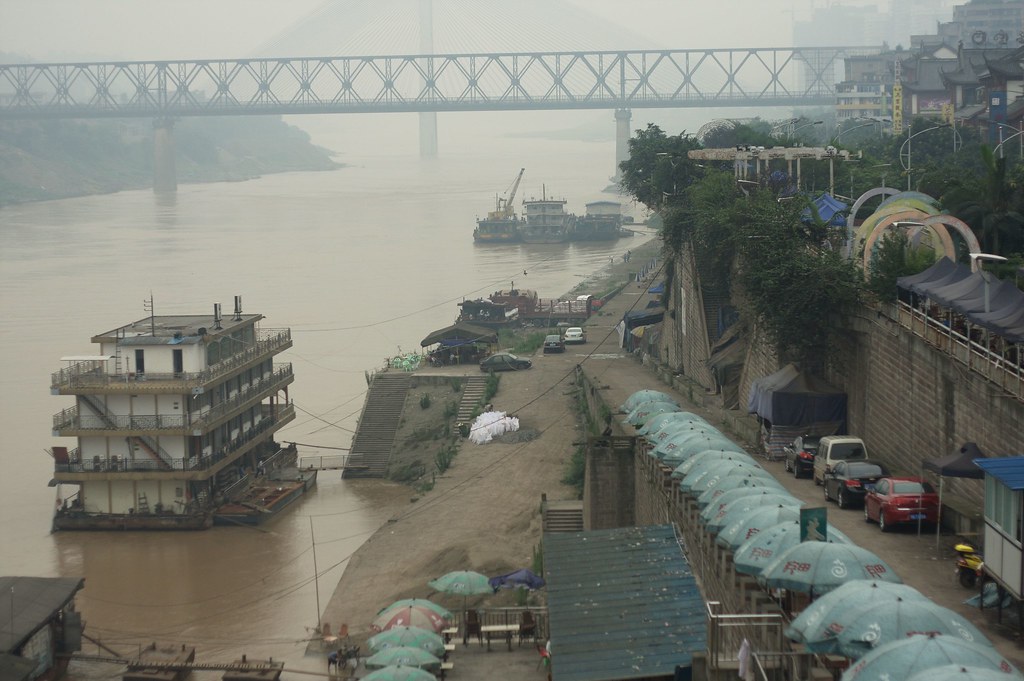I’ve discussed the port at Duluth, Minnesota (map) before and even created a travel page for it. I was particularly fascinated with the bit of trivia that Duluth was a significant seaport even though it was located 2,342 miles (3,770 kilometres) from its eventual outlet to the Atlantic Ocean.

The Duluth Seaway Port Authority described itself as “the largest, farthest-inland freshwater port.” Maybe that was the case and maybe that was hyperbole. Claims are cheap. Either way I though I should check into this a little further and see what other candidates might exist. I discovered a very useful website in the process, the World Port Source, which provided interactive maps by inland waterway.
Like all my geo-oddity searches, I establish some ground rules. I was looking for a port, most importantly. That was far different than the longest navigable river. Anyone could take a canoe farther upstream. I was looking for recognized port facilities that supported commercial shipping. That was also different than the farthest point upriver negotiable by an oceangoing deep-draft ship. One simply won’t be able to get a large oil tanker hundreds of miles upstream. So those were the general parameters.
Examining North America
Duluth would be tough to beat. It definitely held the record for North America. Canada did well with the Port of Thunder Bay in Ontario (map) — like Duluth, on Lake Superior — although Duluth was at the farthest extreme of the lake so that increased its distance from the Atlantic.
The Port of Lewiston, Idaho was the farthest U.S. inland port from the Pacific Ocean via the Columbia and Snake Rivers, some 465 river miles (750 km) upstream (map). It also had the distinction of being the only port city in the state of Idaho, which was an interesting bit of trivia worth filing away and retrieving at a strategic time. Maybe I’ll use that one on my wife some day just to watch her eyes roll.
For the Mississippi River watershed and the Gulf of Mexico though, the farthest inland port was either Minneapolis or St. Paul. The Port of Minneapolis might not exist anymore because city officials were eager to get rid of it as recently as 2012. That would hand the honor over to the nearby Port of St. Paul about 1,670 miles (2,690 km) upriver from the Gulf (map).
I then turned to the aforementioned World Port Source to examine additional extremities outside of North America.
Amazon River – Iquitos, Peru

The vastness of the Amazon River truly amazed me. Examine the placement of Iquitos, Peru on a map and specifically how far west it fell on the South American continent. Ponder for a moment that the waterway it sits upon drains to the east.
The Port of Iquitos, Peru can be accessed after traveling upriver some 2,300 miles (3,700 km) which put it in the same ballpark as Duluth. One location might be slightly farther inland than the other, or not, although either way they were essentially the same for practical purposes. World Port Source noted:
“The Port of Iquitos became important to the country in the late 19th Century with the rubber boom. The Port of Iquitos is the biggest city in Peru’s rainforest and the capital of the large Department of Loreto. Many think that the Port of Iquitos is the biggest city in the world that roads do not reach. In 2005, almost 154 thousand people lived in the Port of Iquitos”
“The biggest city in the world that roads do not reach!” — more fascinating trivia. Is someone writing these down?
Yangtze River – Yibin, Sichuan, China

Once again, ponder the distance the Yangtze River penetrates inland to the Port of Yibin (map). It was hard for me to find an exact figure on the river miles between Yibin and the East China Sea. By extrapolation it seemed to be about 1,750 miles (2,800 km).
Certainly one could travel much farther upriver although Yibin seemed to be the final commercial port, and it’s become quite active. I found a recent article in SeaNews that described how train locomotives made in Sichuan were being shipped internationally from the Yibin port. The article also said that as of January 2014, “Cargo vessels of 1,000 tonnes can sail between the port and the sea year round.”
I didn’t have time to consider every possibility for farthest inland port. Additional candidates could include the Port of Tver, Russia on the Volga River system or the Port of Kelheim, Germany on the Danube River system. Still it satisfied my curiosity. It confirmed that freighters could sail mighty far inland on multiple continents.

Leave a Reply